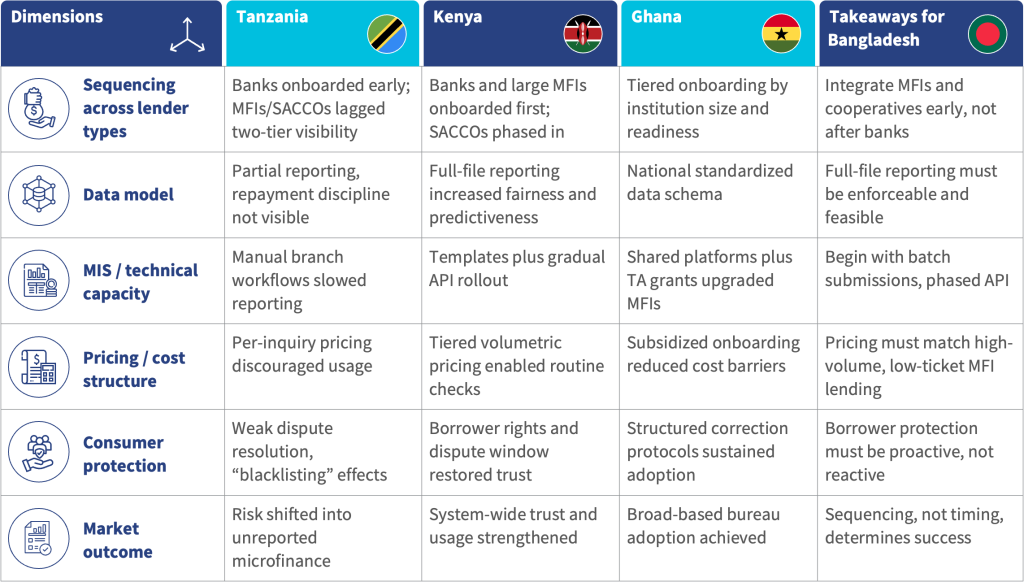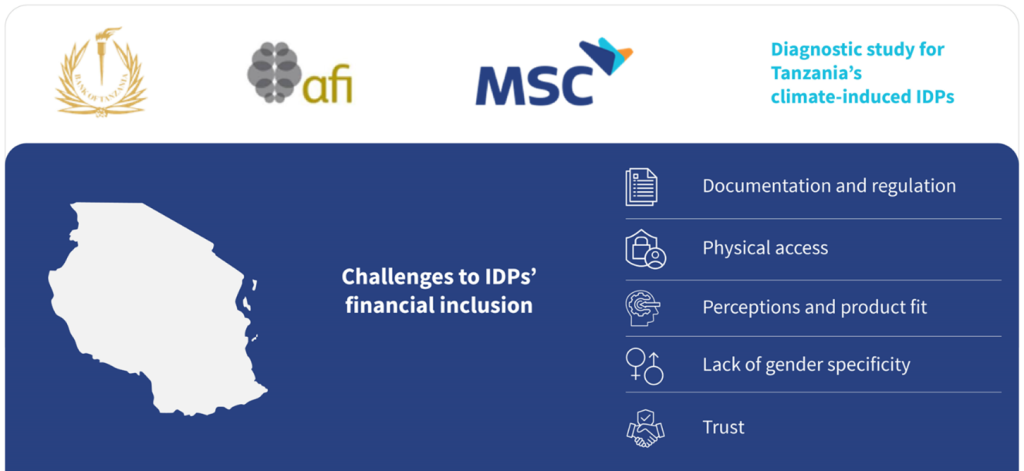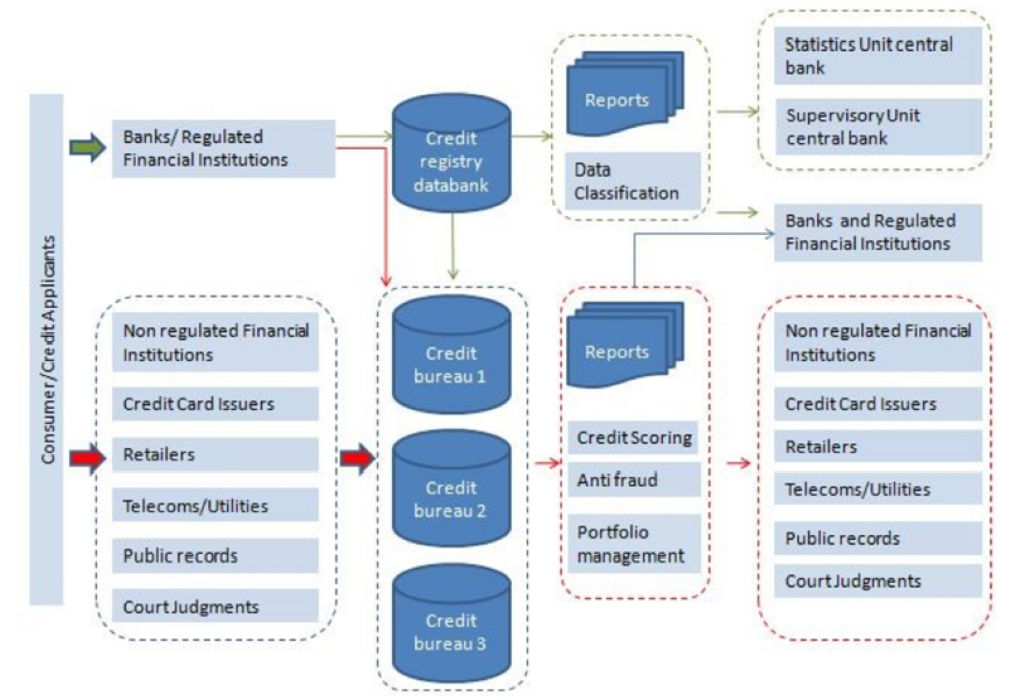In this three-part series, we scrutinized the shift toward multiple credit bureaus for financial service providers (FSPs) in Bangladesh. The first part discussed the implications of the framework for multiple credit bureaus, while the second part focused on regulators and development partners (DPs). In this final part, we examine market incentives and global lessons that show how a multi-bureau system can drive financial inclusion on a large scale.
The multi-bureau reform enables Bangladesh to shift from a collateral- and relationship-based credit identity to a performance-based one. This change creates opportunities for MSMEs, informal workers, and new borrowers who previously struggled in the formal financial system.
Private credit bureaus can expand the basis to assess creditworthiness for these segments of borrowers, as they primarily assist borrowers without formal income documentation or collateral. While many low-income households and informal workers repay their debts reliably, their financial discipline remains hidden within single lenders.
Alternative data, such as mobile money transactions and utility payments, holds immense potential to serve such thin-file borrowers. However, the near-term priority for the regulator and the market must remain on standardizing and ensuring full-file reporting of traditional credit data from banks, MFIs, and cooperatives. Alternative data can only strengthen scoring after this core foundation becomes robust and reliable, which means its full utility is a second-stage integration.
When bureaus participate in the credit ecosystem, they make repayment history portable across the financial sector. This portability allows lenders to evaluate borrowers based on their repayment track record rather than their physical assets. The transition enables gradual increases in loan size over time. Eventually, as borrowers build their credit profiles, they can then move from microfinance products to formal enterprise loans. This progression represents a fundamental shift in how financial institutions view the creditworthiness of customers in emerging markets.
Most lenders globally treat bureau scores as only a first-level filter in their decision process. This initial screening may restrict credit access for borrowers with limited credit histories and thin credit files for lenders to assess their creditworthiness accurately. Still, borrowers typically can access more credit over time, as their data becomes richer and more comprehensive. The challenge lies in how consistently the market applies these scores and filters rather than rely solely on credit scores.
For Bangladesh, consistency has emerged as a more critical issue as the country moves forward with its reforms. The Bangladesh Bank issued letters of intent (LoI) to five companies to form credit bureaus: Creditinfobd, TransUnion, bKash Credit, First National Credit, and City Credit. Later, TransUnion and bKash announced that they would establish a joint company, which reduced the number of credit bureaus to four. These four private bureaus will now enter the market with different methodologies.
Consistency will be paramount for the market to trust this multi-bureau system. This depends on three core elements:
- Data definitions: The exact borrower attributes being captured and reported, such as loan type, repayment status, and delinquency buckets;
- Weighting logic: How different variables, such as repayment behavior, outstanding exposure, and frequency of defaults, are weighted within the score;
- Score calibration: How raw risk estimates are translated into standardized score ranges so that scores are comparable and predictive.
If the scoring models diverge significantly, lenders may over-rely on the most conservative scores available. They may also avoid bureau insights altogether and return to traditional assessment methods, which include requiring collateral, relying solely on fixed income in the form of pay stubs, or using manual relationship-based assessments. This outcome would limit the benefits for low-income and MSME borrowers who need these new pathways the most.
The Bangladesh Bank maintains direct oversight over the scoring process to prevent this fragmentation. These regulatory safeguards are central to consistency and consumer trust:
- Mandatory model approval: The central bank requires mandatory model approval for all credit bureau scoring methodologies.
- Non-discriminatory scoring: Guidelines explicitly prohibit the collection of sensitive attributes, such as political affiliation or religious beliefs, to prevent bias.
- Score as a filter: A critical protection mandates that lenders cannot rely solely on a bureau’s score; it must be used as only one structured input among others in the credit decision process.
The impact of this bureau reform also depends on the digital readiness of lenders across the market. Smaller FSPs with manual data workflows struggle with consistency and timeliness. Borrowers cannot fully use their reputation capital when technical limitations obscure credit history. The infrastructure must support seamless data exchange to realize the reform’s full potential.
True inclusion requires the definition of creditworthiness to expand beyond formal loan repayment data. The system must incorporate behavioral indicators, such as mobile money patterns, utility payments, and savings behavior. These indicators accurately reflect financial reliability in informal settings where traditional credit histories are absent. The challenge lies in how bureaus translate diverse data sources into robust models that lenders will trust.
Pakistan offers relevant examples through platforms, such as Jumo and JazzCash, which use mobile money transaction patterns to determine internal credit scores. Bangladesh can adopt similar approaches where bureaus recognize financial progress through non-traditional indicators.
Similarly, Africa offers valuable lessons from credit bureau transitions. If participation remains uneven, a “two-speed” credit market emerges. Global lessons, particularly from Tanzania and Kenya, demonstrate that when reporting is mandatory only for banks and not fully integrated by MFIs, credit discipline improves in the formal sector. However, this change merely shifts over-indebtedness to the segments that remain unreported. This is the key risk for Bangladesh in terms of financial stability.
If MFIs and cooperatives lag in both reporting and the use of bureau data, credit risk migrates into unregulated segments. Bangladesh must address this immediately to ensure the reform strengthens the financial sector.
Tanzania and Kenya saw banks adopt bureaus early, but microfinance institutions (MFIs) and savings and credit cooperative organizations (SACCOs) lagged significantly. This gap shifted over-indebtedness problems to unreported segments. Meanwhile, Ghana shows that broad visibility across all lender types is achievable. The country sequenced onboarding by institutional capacity and provided smaller lenders with dedicated technical support.
Bangladesh must integrate MFIs and cooperatives early in the implementation process to prevent a two-tier system where only formal banks benefit from shared data. The integration should follow a phased approach that starts with standardized batch submissions. The system can transition to real-time API checks as capacity improves.
Comparative lessons from the implementation of credit bureaus in Africa

Source: Created by MSC with inputs from Maxwell Investment Group and Zeeh
Credit bureau pricing structures must support high-volume, small-ticket transactions that characterize MSME and microfinance markets. Per-inquiry fees discourage routine use by MFIs and merchant lenders, which operate on thin margins. Volume-based or institutional flat-rate models support regular bureau checks without prohibitive cost barriers.
Beyond access fees, bureaus must provide decision-ready intelligence over raw data dumps. They should deliver standardized scorecards and risk dashboards that help lenders apply bureau information meaningfully in their underwriting processes. Many smaller lenders lack the technical capacity to build proprietary models from scratch.
Regulatory authorities and governments must establish consumer protection frameworks alongside technical infrastructure. Kenya’s experience shows that negative-only systems can entrench exclusion rapidly when borrowers cannot recover from mistakes. Borrowers must have clear rights to access, dispute, and correct their records. Improved data infrastructure alone will not automatically change credit decisions in the market. FSPs must treat bureau information as a primary input that actively influences loan amounts, interest rates, and repayment terms.
A major tension in the transition is between regulatory enforcement (reporting data) and voluntary participation (using data). Specifically for MFIs and high-volume digital lenders, cost and workflow friction often drive this tension. If bureau access is priced per inquiry or per user, institutions may report data to comply with regulations but limit bureau checks in practice, which would render the bureau a passive repository rather than a live decision-making tool.
Regulators must, therefore, establish a supportive pricing model, such as volume-based or institutional pricing, which makes high-frequency, low-cost access viable for all lender segments to ensure lenders use the bureau in underwriting.
Regulators, DPs, and FSPs must prioritize three critical elements in their execution:
- Ensure broad participation across all lender types from the start;
- Establish strong data standardization that creates consistency across bureaus;
- Enforce proactive consumer protection measures to build trust in the system.
The success of Bangladesh’s multi-bureau system depends on operational choices and specific implementation plans, rather than broad policy goals. The sequence of implementation matters more than the speed of rollout. If made sensibly, these coordinated efforts will unlock the full potential of Bangladesh’s credit bureau reform and carve pathways to financial inclusion for people who have been excluded for far too long.













